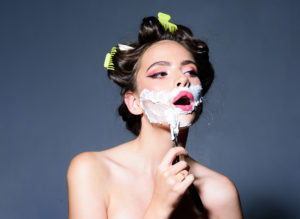 Brazilian wax or full bush? Keratin treatments or natural hair?
Brazilian wax or full bush? Keratin treatments or natural hair?
Like it or not, hair is a feminist issue. Perhaps its always been, in a culture where hairstyle and hair removal are tightly linked to ideas about masculinity, femininity, social status, and beauty.
Turns out, hair has always been powerful.
The Spiritual Power of Hair
Hair has been linked with femininity dating back to the Bible, which declares in I Corinthians 11 that a woman’s long hair is her crowning glory.
But recall the story of Samson, a legendary Israelite warrior who derived his power from his uncut hair. After the prostitute Delilah—they’re always prostitutes—learns his secret, she cuts his hair. Samson ends his days in a Philistine prison, blind, powerless, and defeated.
Many religions and cultures believe hair has special significance.
Sikhs refrain from cutting or removing hair from any part of their body to maintain the form which God gave them.
Rastafarians wear their hair in long dreadlocks as physical proof of their devotion to God, while Buddhists and Hindus shave their heads to as part of their promise to God.
Some Orthodox Jewish families wait until a boy’s third birthday to cut his hair in a ceremony called chalakah or upsherin, and long hair can be an important part of cultural identity for members of Native American tribes.
Still, we associate long hair with women.
Except, of course, when we don’t. Picture for a moment the long hair biker, and other subversive types. It’s quaint now, but the Beatles were considered rebellious for sporting collar-length hair.
The Weird History of Body Hair Removal
Body hair removal can be traced back to the Stone Age, when men and women shaved their heads and faces with sharpened rocks.
The first razors appeared in Egypt and India around 3000 BCE. By the reign of Cleopatra, (51-30 BCE), Egyptian men and women removed most of the hair from their bodies, heads and pubes included, using a method similar to waxing.
In the 6th century BCE, upper-class Roman women used tweezers, pumice stones, and depilatories, while Elizabethan women from noble families plucked the hair from their foreheads to lengthen their brow.
In 20th century America, body hair removal followed women’s fashion trends.
In the early 1900s, even the word “underarm” was considered scandalous. Then in 1915 the sleeveless dress came into fashion, necessitating the removal of “objectionable hair,” as fashion magazine Harper’s Bazaar so delicately put it.
By the 1920s, shaved armpits were compulsory. But even with shorter hemlines, women didn’t worry too much about the rest of their bodies.
The 1940s brought shorter skirts and more translucent stockings, and American women were convinced to shave their legs.
I guess what’s old is new again. The first full body wax hit America in 1987 and spread by word of mouth and the hit TV show Sex and the City.
Body Hair Positivity
Hair is deeply personal and always controversial.
Hair removal—legs, armpits, and pubes—is a chore many women submit to with varying degrees of resentment.
We discuss facial hair in hushed tones with female friends. But how many women admit to regularly shaving their hands, feet, or stomach?
These are secrets we learn to keep, first from our mothers, then from our friends and society at large.
Women who can’t or won’t meet the Western ideal of a nearly hairless body suffer.
Like Harnaam Kaur, a 23-year-old Punjabi woman who was diagnosed during puberty with polycystic ovary syndrome.
Teased mercilessly for her full beard, Kaur became depressed and suicidal.
Body hair positivity—think Miley Cyrus with her brightly colored armpit hair—has been criticized as a movement that excludes women of color, who often have courser hair in more places.
Obviously not all white girls are Nordic blondes with socially acceptable peach fuzz.
It is an act of bravery when any woman breaks the unwritten rules of Western culture, which demand a mostly hairless body.
But when we show off our unshaved armpits, let’s not forget our sisters with sideburns, back hair, and beards, who are often haunted by their inability to meet Western standards of beauty.
Fortunately, Kaur’s story has a happy ending. She emerged from the darkest place as an activist, model, life coach, and icon of the body positivity movement.
We can learn a lot from her.
